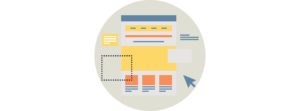Good web design does not just appear by chance, there are many aspects of design that come together to achieve it. This second of a series of articles explores four (web) design principles that will mark a starting point, if considered, to make your website aesthetically pleasing, easy to use, engaging, and effective. As we provide a free website-testing service for all GI-Mail readers, we would like to invite you to submit your website through our submission form to receive a free report of your site’s current state. Feel free to submit your site here.
#1 ALIGNMENT
A website with poor alignment looks like a messy and unorganized desk. It is hard to search for the things you are looking for and it is unattractive to look at. So alignment is vital for a well structured health care website. All elements used on your site should be aligned with at least one or more other elements provided on your interface. Alignment creates a sense of unity and makes your design perceived as stable and aesthetic.
#2 COLOR
There are approximately 16.8 million colors to choose from when you start building a healthcare website. Combining your chosen base colors into a color palette the combination possibilities rise to near infinite numbers. Besides the pain of the path to find the right colors, the use of it will be a real contribution to your design. It will make your design more interesting, can reinforce the meaning of the elements and your users will perceive your design as more interesting.
#3 LATCH
“Information may be infinite, however… The organization of information is finite as it can only be organized by LATCH: Location, Alphabet, Time, Category, or Hierarchy.“ – Richard Saul Wurman, Information Architect
Location, Alphabet, Time, Category, Hierarchy – is it really that simple to organize information?
Yes, it is. Almost every information can be arranged following the LATCH² rule. It is also a common pattern for users to hold on to, so it would be smart to organize the information provided on your healthcare website according to LATCH, to make your website more usable and easier to search.
#4 THE GUTENBERG DIAGRAM & THE F-PATTERN
The Gutenberg Diagram³ is used to display a behavior that is also known as “reading gravity” – the western habit of reading information left-to-right, top-to-bottom. In contrast to the Gutenberg reading pattern, the “F-Pattern”4 – F stands for fast – is used by users just scanning your website in a few seconds. Understanding the reading patterns of your users enables you to place the most important content in the areas where they will be most effective.
YOUR WEBSITE
As part of an ongoing cooperation between “Going International” and “dsgn&cde” we are happy to provide you a free healthcheck of your website. In order to get your free report on your website’s current state, please fill out our submission form.
WEB TIP OF THE MONTH
Take your presentations with “Prezi” to the next level.
Footnotes
1) http://www.imdb.com/title/tt0758758/?ref_=fn_al_tt_1
2) http://www.informit.com/articles/article.aspx?p=130881&seqNum=6
3) https://prezi.com/wn4dsbvwwujk/dasgutenbergdiagramm
4) https://www.nngroup.com/articles/f-shaped-pattern-reading-web-content/



